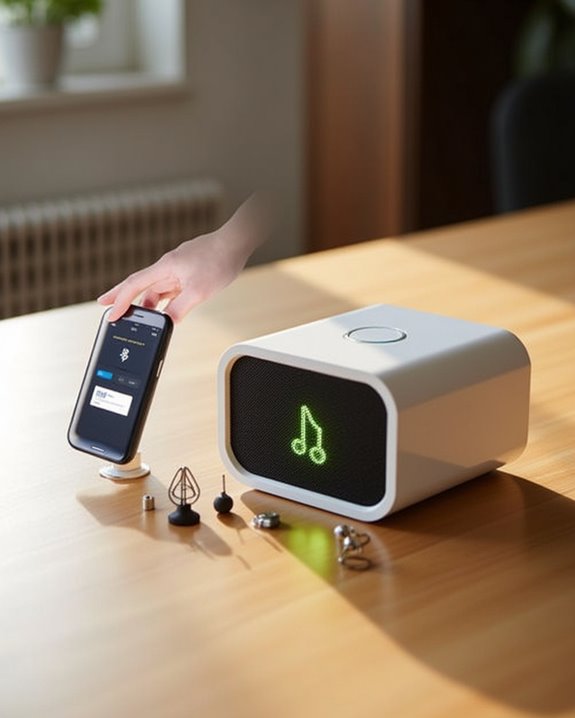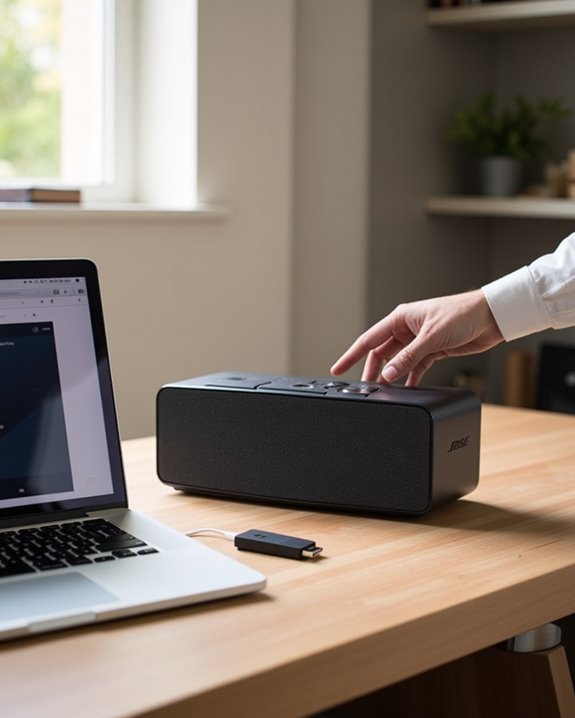Converting a Bluetooth speaker to a smart speaker requires pairing it with a voice-activated device like Amazon Echo Dot or Google Nest Mini, both featuring Bluetooth 5.0 and AI processors for stable connections and voice control. Ensuring compatibility with standardized protocols such as A2DP and AVRCP is essential. Ideal performance involves proximity within three feet to reduce latency, with devices like the Edifier S1000MKII offering high-fidelity audio at 90W RMS power. Advanced setup includes managing connections and integrating smart home controls. Further guidance explains detailed pairing and optimization techniques.
Key Takeaways
- Connect a smart assistant device like Amazon Echo Dot or Google Nest Mini to your Bluetooth speaker for voice control and AI features.
- Put the Bluetooth speaker in pairing mode and use the companion app (Alexa or Google Home) to scan and pair with the smart device.
- Ensure devices are within three feet and use Bluetooth 5.0 or higher for stable, low-latency connections.
- Use voice commands to control playback, volume, and smart home functions through the newly connected smart speaker setup.
- Manage multiple speakers and troubleshoot by unpairing, restarting devices, and avoiding interference from other Bluetooth connections.
Benefits of Pairing Bluetooth Speakers With Smart Devices
When paired with smart devices such as the Amazon Echo Dot or Google Nest Mini, Bluetooth speakers gain substantial enhancements in functionality and audio performance, driven by advanced cloud-based processing and AI integration. This pairing combines the Echo Dot’s Alexa or Google Assistant capabilities with high-fidelity Bluetooth speakers, resulting in improved sound clarity, bass response, and dynamic range. This setup allows users to enjoy a smart sound experience without investing in dedicated smart speakers. Users benefit from voice-activated convenience, enabling hands-free control of audio playback, volume adjustment, and smart home integration without additional hardware costs. Furthermore, compatibility with WiFi extends connectivity, transforming entry-level speakers into versatile, portable AI-powered systems. Devices like the Echo Dot, often available at discounted prices starting around $30, offer an affordable upgrade path. This configuration enhances both audio quality and smart functionality, providing an accessible solution to elevate everyday listening experiences.
Choosing the Right Smart Speaker and Bluetooth Speaker Combination
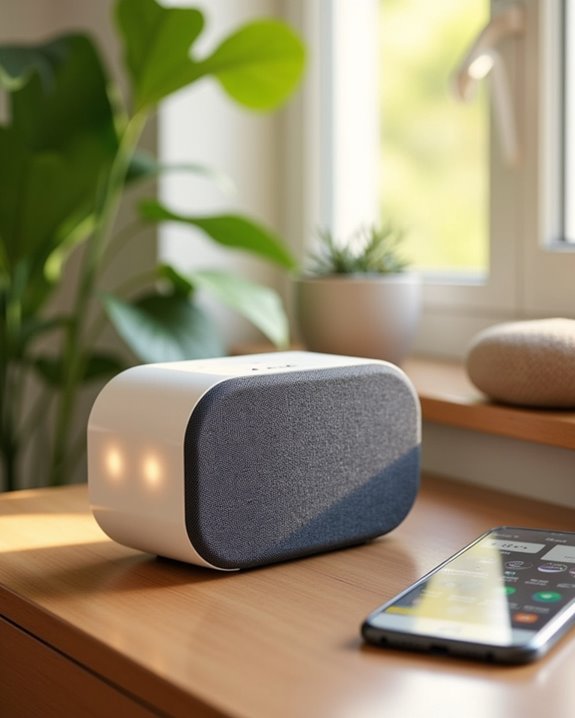
Selecting an affordable smart speaker such as the Amazon Echo Dot or Google Nest Mini, both equipped with essential AI processors and Bluetooth 5.0 connectivity, provides a cost-effective control hub for pairing. When combined with a high-fidelity Bluetooth speaker like the Edifier S1000MKII, featuring a frequency response of 50Hz–20kHz and 90W RMS power output, users achieve enhanced audio performance while maintaining voice command functionality. Compatibility is critical; devices must support standard Bluetooth profiles (A2DP, AVRCP) for seamless integration, and proprietary systems like Apple’s HomePod mini are incompatible, limiting pairing options.
Affordable Smart Speaker Options
Affordable smart speaker options present a practical foundation for upgrading audio systems by combining voice-activated devices with high-quality Bluetooth speakers, enabling enhanced sound reproduction and intelligent control. The Amazon Echo Dot, typically priced around $30 during sales, offers seamless pairing with various Bluetooth speakers, including mid-range wireless speakers, to elevate audio quality without excessive cost. Google smart speakers, such as the Nest Mini, present a competitive alternative with similar pricing and compatibility. Both Echo Dot and Nest Mini devices support stable wireless connections and voice assistant functionalities, facilitating convenient control. Older or refurbished models provide additional budget-conscious choices. Users should prioritize compatibility, as these smart speakers effectively connect with most Bluetooth speakers, unlike Apple HomePod mini, ensuring a versatile and scalable smart audio system starting near $80 total investment during promotions.
Selecting High-Quality Bluetooth Speakers
Although the choice of a smart speaker forms the foundation of a smart audio system, pairing it with a high-caliber Bluetooth speaker greatly enhances sound fidelity, dynamic range, and overall listening experience. Users should pick speakers to pair by focusing on top-ranked models such as the Edifier S1000MKII, noted for its detailed frequency response and robust amplification, delivering a speaker with good sound that outperforms entry-level options. Consumer Reports’ testing programs emphasize speakers with low distortion and wide stereo imaging, qualities present in wireless speaker with good credentials like the Sonos Five. Older Amazon and Google smart speakers, including refurbished Echo Dot and Nest Mini units, maintain compatibility with high-quality Bluetooth speakers, enabling cost-effective setups. Selecting smart speakers and wireless devices with proven interoperability guarantees seamless integration and superior audio performance.
Compatibility Considerations
When integrating a smart speaker with a Bluetooth speaker, compatibility hinges on adherence to standardized Bluetooth protocols and device interoperability, which guarantees stable pairing, low latency, and ideal audio transmission. The Echo Dot and Google Nest Mini stand out as the most compatible smart speakers due to their reliable Bluetooth capability and affordable pricing, starting near $30 during sales. Users should consult the user guide to activate pairing mode correctly and pair your devices effectively. Particularly, Apple HomePod Mini lacks compatibility for connecting external Bluetooth speakers, limiting options. High-end Bluetooth speakers like the Edifier S1000MKII, priced around $350, excel in seamless integration with Echo Dot or Nest Mini, enhancing audio quality via stable connections. Ensuring the Bluetooth speaker supports standard protocols prevents pairing conflicts and facilitates smooth connect your speaker operations among Bluetooth devices.
Preparing Your Devices for Pairing
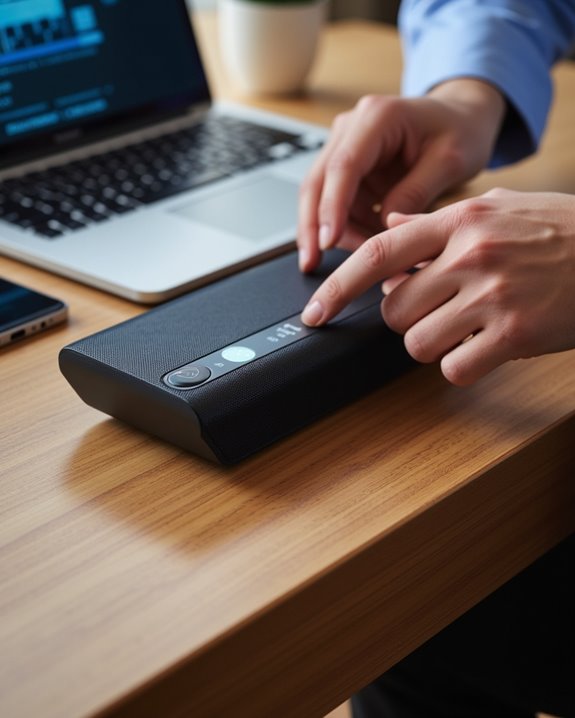
Prior to initiating the pairing process, it is essential to position the Bluetooth speaker and smart speaker, such as an Echo Dot or Google Nest Mini, within a proximity of less than three feet to maintain a stable Bluetooth connection, thereby reducing latency and signal interference. Both devices should be turned on and unpaired; the Bluetooth speaker must be in pairing mode, typically activated by pressing the pairing button or holding the power button until an indicator light flashes. It is vital to disconnect any other Bluetooth devices from both units to prevent conflicts during pairing. Additionally, make sure the Bluetooth speaker’s volume is turned up and both devices are fully powered and ready to receive signals. These steps maximize pairing efficiency and optimize audio performance once connected. For the best experience, select Bluetooth speakers with advanced connectivity features such as Bluetooth 5.0 or higher to ensure a reliable connection and extended range.
Step-By-Step Guide to Pairing Amazon Echo Dot With Bluetooth Speakers
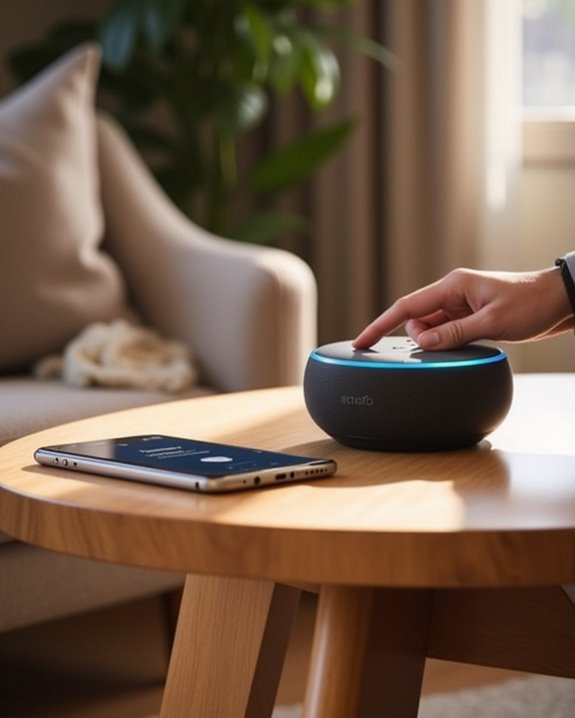
The initial phase requires precise preparation of the Amazon Echo Dot and Bluetooth speaker, ensuring both devices are within a 3-foot range, powered on, and free from interference by disconnecting other Bluetooth connections. Following activation of the speaker’s pairing mode, the Alexa app facilitates the scanning and connection process through its Devices section, enabling seamless integration. Post-pairing, users can manage device settings within the app, with the Echo Dot supporting automatic reconnection and voice-command initiation for enhanced operational efficiency. Additionally, utilizing the sound quality features of the Echo Dot can improve your overall music experience when pairing with external speakers.
Preparing Devices for Pairing
A thorough preparation phase involves guaranteeing the Amazon Echo Dot is fully configured and connected to a stable WiFi network, which is critical for initiating Bluetooth pairing protocols. During initial setup, the Bluetooth speaker should be turned on, with the volume on the speaker adjusted to a moderate level to verify operational status. Users must disconnect all other devices from both the Echo Dot and the Bluetooth speaker to prevent interference. Activating pairing mode requires pressing and holding the speaker’s power button or a dedicated Bluetooth button until a flashing light signals discoverability, enabling the Echo Dot to begin scanning for devices. Maintaining a proximity of no more than three feet between devices ensures ideal signal strength, facilitating a seamless connection when selecting “Pair a New” device on the Echo Dot interface.
Connecting Echo Dot Bluetooth
Successful initiation of Bluetooth pairing between an Amazon Echo Dot and an external speaker depends on methodical execution of device settings and interface navigation. First, make sure the Echo Dot is active and the Bluetooth speaker is powered on with volume up. Disconnect prior Bluetooth devices on both units to prevent interference. Activate pairing mode on the Bluetooth speaker, indicated by a flashing light, making it discoverable. Open the Alexa app, navigate to Devices, select the Echo device, and initiate “Pair and connect” to begin scanning for devices. Once the Echo Dot discovers your Bluetooth speaker, select it to complete fine pairing. Subsequent connections benefit from Auto-connect functionality, enabling voice command reactivation via “Alexa, connect,” streamlining future use and enhancing user convenience.
Managing Paired Device Settings
How does one effectively manage paired device settings to optimize the interaction between an Amazon Echo Dot and Bluetooth speakers? Users should open the Alexa app, tap the icon for Devices, then screen and select Devices to view the list of available devices. From there, select the Echo Dot and pair only one device at a time to avoid conflicts. The Dot should automatically pair with the Bluetooth speaker in future uses, enabling auto-connect in the future for seamless playback. To control your wireless connection, users can ask Alexa to connect to the last paired device or manually manage settings within the app. This approach guarantees efficient management of paired devices and allows users to control a Bluetooth speaker reliably, enhancing their smart speaker experience.
Step-By-Step Guide to Pairing Google Nest Mini With Bluetooth Speakers
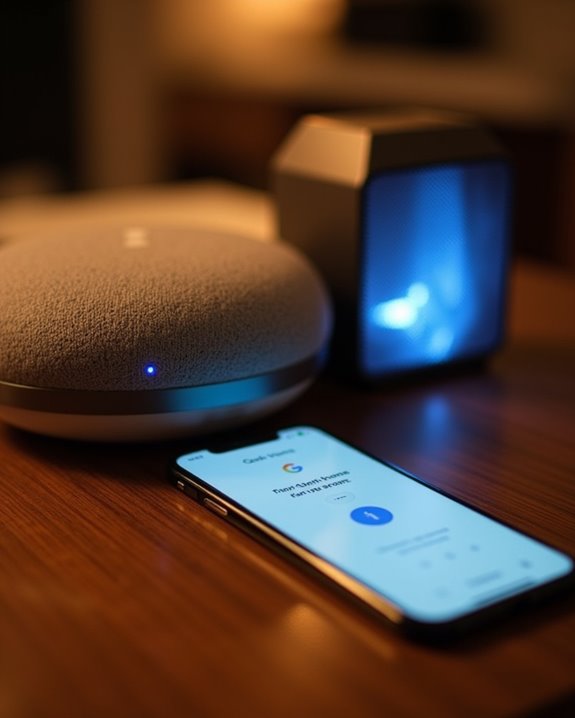
Pairing a Google Nest Mini with a Bluetooth speaker involves a multi-step process that guarantees ideal audio output by leveraging wireless connectivity protocols and device compatibility features. First, make sure the Bluetooth speaker is powered on and set to pairing mode within close range of the Google Nest Mini. Using the Google Home app, access the Nest Mini’s settings, then select “Default Speaker” and tap “Pair Bluetooth Speaker” to initiate scanning for devices. The app detects available Bluetooth speakers; upon selecting the desired device, a connection is made. This pairing enables the smart speaker to play music through the external Bluetooth speaker, enhancing functionality and convenience. The connection auto-establishes for future sessions unless manually disconnected, optimizing seamless audio performance for integrated smart home environments.
Managing Bluetooth Connections and Switching Between Speakers
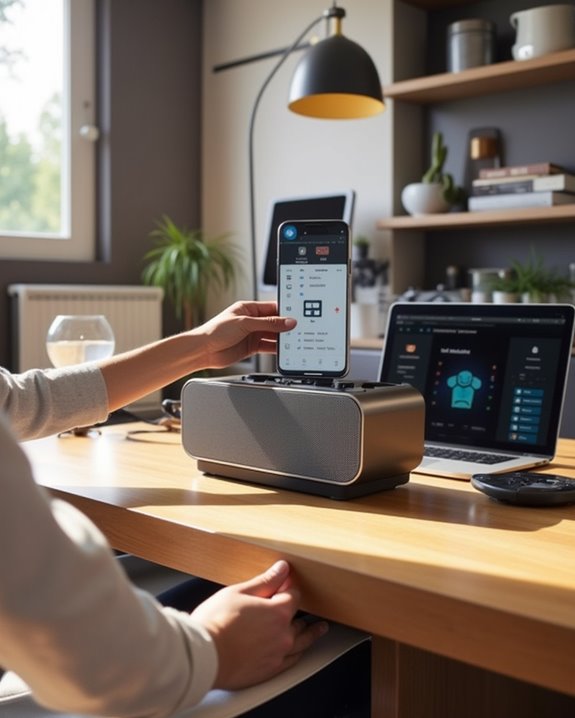
Managing Bluetooth connections and switching audio output between multiple speakers requires a methodical approach to avoid connectivity conflicts and guarantee consistent performance. Alexa-powered devices, such as the Echo Dot, often auto-connect to the Bluetooth speaker currently active, complicating manual switching. Users benefit from setting up multiple Echo Dots paired individually to dedicated smart speakers, enabling voice-directed playback without repeated pairing. Scanning for devices and recognizing already connected speakers reduces connection errors. Smart Plugs complement this setup by powering specific speakers on or off remotely, streamlining control. Integration with Ask Alexa software enhances device management by resolving pairing conflicts and improving command specificity. These strategies collectively optimize playing music across various Bluetooth speakers, ensuring seamless switches and reliable connectivity within smart home audio networks.
Using Smart Plugs for Voice-Controlled Speaker Power Management
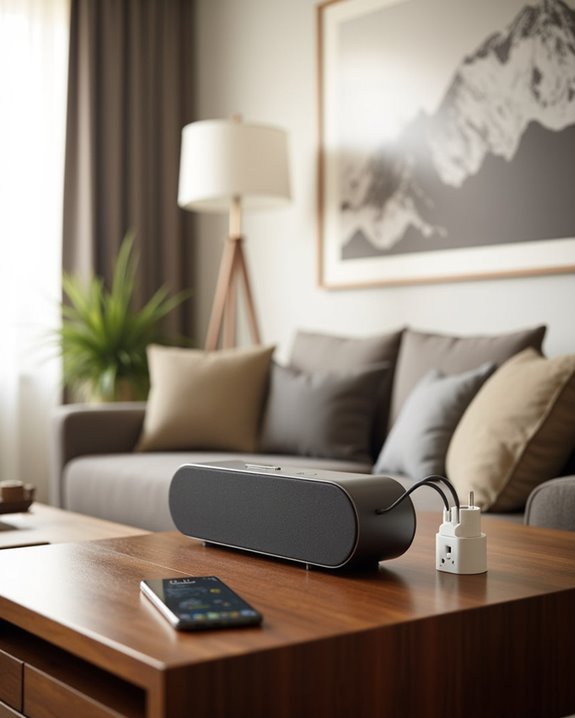
In what ways can smart plugs enhance the operational efficiency of Bluetooth speaker systems within voice-controlled environments? Smart plugs enable users to manage power to a Bluetooth speaker directly, transforming a conventional speaker into a smart speaker that’s connected to a digital voice assistant like an Alexa-powered Dot. By integrating smart plugs, users gain the functionality to turn speakers on or off via voice commands, resolving pairing conflicts common in WiFi but uses Bluetooth devices. This setup streamlines activation before Alexa pairs to send music, ensuring seamless control over multi-speaker environments connected to the internet—and compatible with smart devices like smart lightbulbs—by managing power states without manual intervention. The digital voice assistant offers efficient audio output switching, automatically reverting to the default speaker when a smart plug disables a device, enhancing overall system responsiveness.
Integrating Third-Party Apps to Enhance Speaker Control
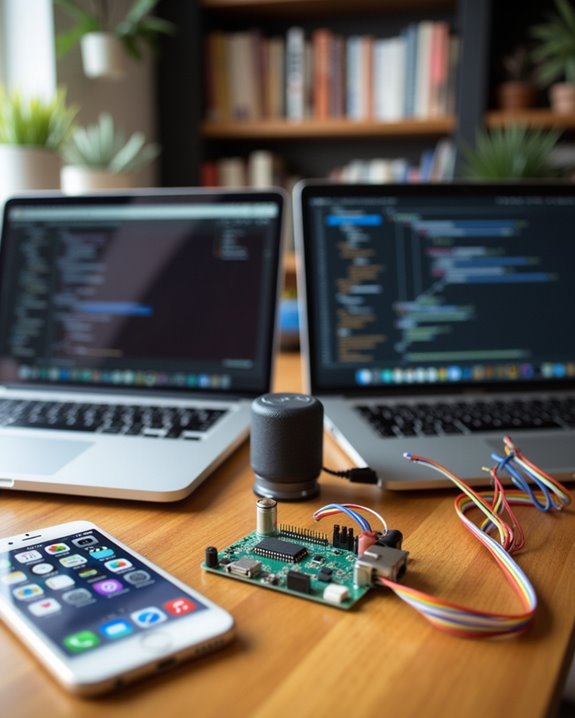
Expanding control capabilities beyond power management, third-party applications such as Ask Alexa provide advanced solutions for handling multiple Bluetooth speaker pairings within smart home ecosystems. This program for smart speakers enables users to efficiently connect and switch between devices, overcoming common Bluetooth limitations. Ask Alexa’s integration allows Alexa-powered devices to discover your Bluetooth speakers and control them via keyword triggers, streamlining audio routing without manual intervention. It works with other Alexa-powered smart devices, facilitating cohesive voice-command management across a network of smart speakers. Community feedback highlights its effectiveness in resolving Bluetooth conflicts and enhancing device interoperability. This guide for your Bluetooth setup recommends Ask Alexa as a reliable tool to optimize multi-device control, ensuring seamless interaction between converted Bluetooth speakers and existing smart device environments.
Tips for Optimizing Your Smart Speaker and Bluetooth Speaker Setup
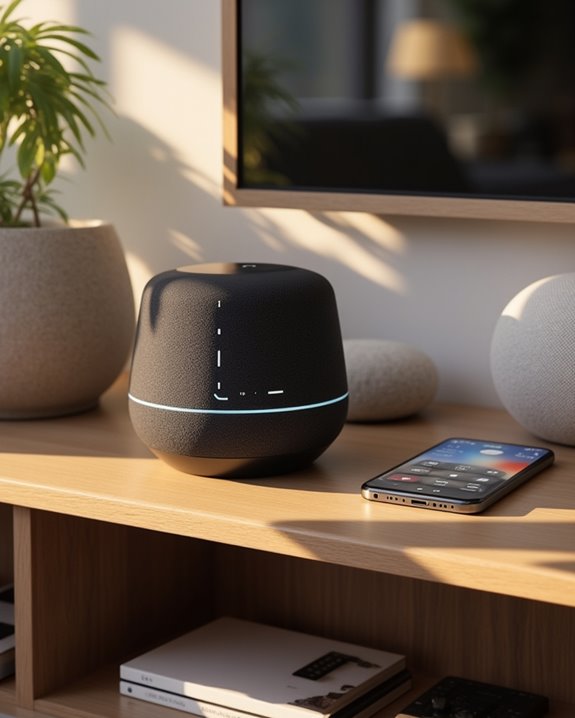
What factors contribute to an efficient and reliable smart speaker and Bluetooth speaker integration? Ideal music setup requires keeping devices in the Alexa or Google ecosystems less than 3 feet apart during pairing, ensuring stable Bluetooth connections. Choosing an Echo Dot or Google Nest Mini, available for approximately $30 during sales, paired with one connected speaker like the Edifier S1000MKII, offers superior sound quality without costly upgrades. Managing multiple smart devices like smart plugs enables room-specific control, allowing automatic power activation via voice commands, enhancing convenience. Troubleshooting involves unpairing through the Alexa app, restarting both speakers, and verifying no conflicting Bluetooth connections. Voice commands such as “Alexa, disconnect my speaker” facilitate seamless switching. Buying an Echo Dot or other smart models from Amazon and Google smart product lines enhances integration, ensuring consistent performance in diverse setups.
Frequently Asked Questions
What Is the Difference Between a Smart Speaker and a Bluetooth Speaker?
Like dawn versus dusk, speaker differences lie in AI features and connectivity types: smart speakers harness WiFi and voice control, offering rich interfaces and evolving usage scenarios, while Bluetooth speakers emphasize sound quality, battery duration, privacy, and affordable price points.
How to Turn Bluetooth Speaker Into Alexa?
Alexa Conversion involves Speaker Retrofit through Firmware Update and Hardware Adaptation, enabling Voice Integration and Echo Emulation. Device Transformation uses API Linking and Skill Addition to achieve Audio Smartening, fostering community connection by embracing shared smart technology experiences.
How Do I Connect My Bluetooth to My Smart Speaker?
Over 60% of users struggle with Bluetooth setup. Device pairing and audio linking require app integration and a compatibility check. Following a setup guide, maintaining signal range, and applying troubleshooting steps guarantee wireless sync and connection tips success.
Can I Connect a Bluetooth Speaker to a Non-Smart TV?
Connecting a Bluetooth speaker to a non-smart TV requires careful device setup, considering TV compatibility and signal range. Adapter options improve audio pairing, but wireless limitations affect output quality. Integration ideas and troubleshooting steps enhance connection tips for best results.


